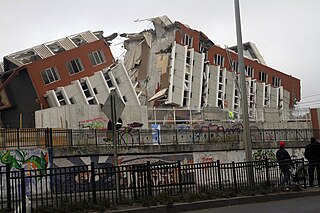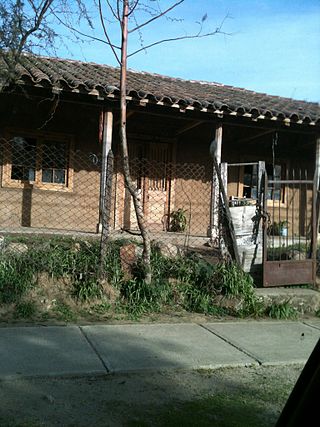
Santiago, also known as Santiago de Chile, is the capital and largest city of Chile and one of the largest cities in the Americas. It is located in the country's central valley and is the center of the Santiago Metropolitan Region, which has a population of seven million, representing 40% of Chile's total population. Most of the city is situated between 500–650 m (1,640–2,133 ft) above sea level.

Valparaíso is a major city, commune, seaport and naval base facility in Valparaíso Region, Chile.

Concepción is a city and commune in south-central Chile, and the geographical and demographic core of the Greater Concepción metropolitan area, one of the three major conurbations in the country. It has a significant impact on domestic trade being part of the most heavily industrialized region in the country. It is the seat of the Concepción Province and the capital of the Bío Bío Region. It sits about 500 km south of the nation's capital, Santiago.

Mendoza, officially the City of Mendoza, is the capital of the province of Mendoza in Argentina. It is located in the northern-central part of the province, in a region of foothills and high plains, on the eastern side of the Andes. As of the 2010 census [INDEC], Mendoza had a population of 115,041 with a metropolitan population of 1,055,679, making Greater Mendoza the fourth largest census metropolitan area in the country.

Curicó is a city located in Chile's central valley and serves as the capital of the Curicó Province, which is part of the Maule Region. Positioned between the provinces of Colchagua and Talca, the region stretches from the Pacific Ocean to the border with Argentina.

Colchagua Province is one of three provinces of the central Chilean region of O'Higgins (VI). Its capital is San Fernando. It is bordered on the north by Cachapoal Province, on the east by the Argentine Republic, on the south by Curicó Province, and on the west by Cardenal Caro Province.

Lolol is a Chilean commune and town in Colchagua Province, O'Higgins Region.

Santa Cruz is a Chilean city and commune, located in the Colchagua valley, in the O'Higgins Region, located on the southern shore of the Tinguiririca river, 110 miles from Santiago, Chile's capital city, and 27 miles from San Fernando.

The 2010 Chile earthquake and tsunami occurred off the coast of central Chile on Saturday, 27 February at 03:34:12 local time, having a magnitude of 8.8 on the moment magnitude scale, with intense shaking lasting for about three minutes. It was felt strongly in six Chilean regions that together make up about 80 percent of the country's population. According to the United States Geological Survey (USGS) the cities experiencing the strongest shaking—VIII (Severe) on the Mercalli intensity scale (MM)—were Concepción, Arauco, and Coronel. According to Chile's Seismological Service, Concepción experienced the strongest shaking at MM IX (Violent). The earthquake was felt in the capital Santiago at MM VII or MM VIII. Tremors were felt in many Argentine cities, including Buenos Aires, Córdoba, Mendoza, and La Rioja. Tremors were felt as far north as the city of Ica in southern Peru. It is the largest earthquake to hit Chile since the 1960 Valdivia earthquake. A 2014 study contended that water pressure built up between the two plates had been the catalyst.
The 1647 Santiago earthquake struck Santiago, Chile on the night of 13 May and is said to have brought virtually every building in the city to the ground. The earthquake was felt throughout the so-called Captaincy General of Chile, an administrative territory of the Spanish Empire. The maximum felt intensity was XI (Extreme) on the Mercalli intensity scale and there were about a thousand casualties.
The 1985 Rapel Lake earthquake occurred on 8 April at with a moment magnitude of 7.2 and a maximum perceived intensity of VI (Strong). The shock was centered 75 kilometres (47 mi) southwest of Santiago, Chile, with a focal depth of 37.8 km (23 mi).

The 1906 Valparaíso earthquake hit Valparaíso, Chile, on August 16 at 19:55 local time. Its epicenter was offshore from the Valparaíso Region, and its magnitude was estimated at 8.2 . This earthquake occurred thirty minutes after the 1906 Aleutian Islands earthquake.

The 2010 Pichilemu earthquakes, also known as the Libertador O'Higgins earthquakes, were a pair of intraplate earthquakes measuring 6.9 and 7.0 that struck Chile's O'Higgins Region on 11 March 2010 about 16 minutes apart. The earthquakes were centred 15 kilometres (9.3 mi) northwest of the city of Pichilemu.

María José Reyes Moore and Juan René Duarte Becerra were murdered in July 2012 in an antique shop in Lolol, Colchagua Province, O'Higgins Region, Chile. Both victims had visited the shop as customers and were attacked and decapitated by shop owner Óscar López Rodríguez.
The following lists events that happened during 1971 in Chile.
The following lists events that happened during 1975 in Chile.
Chilean architecture is influenced by the country's history, religious culture and unique climate. Chile was a former Spanish colony and its architectural style was therefore strongly influenced by Spanish design. Due to the unique geographical environment, Chilean architecture was also designed to accommodate these natural conditions. In particular, Chile's special geologic structure and resultant high incidence of earthquakes and tsunamis have led to Chilean architects becoming quite experienced in the application of structures and materials for earthquake-resistant structures and post-disaster reconstruction.

The Basílica de Nuestra Señora del Perpetuo Socorro is a Latin Catholic Church located in the comuna of Santiago, in the capital of Chile. It was designed in the Gothic Revival style by the religious architects Gustave Knockaert —known as «Brother Gerardo»— and Huberto Boulangeot. They were members of the Redemptorists.
The 1657 Concepción earthquake occurred on March 15 at 20:00 local time off the coast of Concepción, Biobío Region in the Spanish Empire. The earthquake caused severe damage along the coast, and generated a large tsunami in the Bay of Concepción. At least 40 people were killed, the majority due to drowning from the tsunami. The town of Concepción was the hardest hit, with the earthquake and tsunami totally destroying it.













